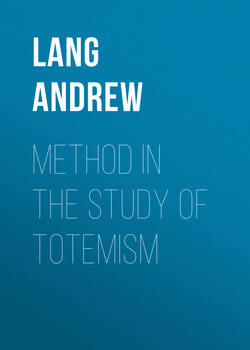Читать книгу Method in the Study of Totemism - Lang Andrew, May Kendall - Страница 2
METHOD IN THE STUDY OF TOTEMISM
II
ОглавлениеMr. Goldenweizer gives what he supposes some of us to regard as "essential characteristics" or "symptoms" of totemism. He numbers five of these "symptoms."
1. An exogamous clan.
2. A clan name derived from the totem.
3. A religious attitude towards the totem, as a "friend," "brother," "protector," &c.
4. Taboos or restrictions against the killing, eating (sometimes touching, seeing) of the totem.
5. A belief in descent from the totem.
Mr. Goldenweizer next, by drawing a contrast between British Columbian and Central Australian totemism, tries to prove, if I understand him, that "the various features of totemism," are, or may be "essentially independent of one another," "historically, or psychologically, or both."6
Now, looking at the five symptoms of totemism, I may repeat (speaking only for myself) that, as to 1 and 2, I think the exogamous clan, with "a clan name derived from the totem" is an institution of such very wide diffusion that I may blamelessly study it and attempt to account to myself for its existence. But this does not mean that I regard all exogamous social sets as at present totemic; or as always having borne totem names. Again, sets of people (I cannot call them "clans," for the word "clan" indicates persons claiming common descent from a male ancestor, – say Clan Gihean, Clan Diarmaid), may bear animal or vegetable or other such names, yet not be at present, as such, exogamous. Of these are the Arunta, and the Narran-ga.
3. A religious attitude towards the totem. One cannot discuss this without a definition of religion. "Totemism is not a religion," says Mr. Frazer, with whom I am here in agreement.
4. Totemic taboos. These, though extremely general, are not quite universal even in Australia.
5. A belief in descent from the totem.
This belief is post-totemic, being merely one of many aetiological myths by which men explain to themselves why they are totemists; what is the nature of the rapport between them and their totems; why they bear as a kin (or association) animal or vegetable names. One or another such myth is not an essential part of totemism, for it is, necessarily, post-totemic.
I am thus left confronting the problems, (1) why are the immense majority of exogamous kins, in societies which we call "totemic," named by animal and other such names; and (2) why are they exogamous?
As for other exogamous social sets, which bear, not animal names, but territorial, or descriptive names, or nicknames, often derisive, it is my business to show, if I can, that these sets, or some of them, have passed, in historical times, out of the stage of totem-kins, owing to circumstances which I shall describe. Next (2) I have to show, if I can, why a few sets of people, bearing, as sets or associations, animal or other such names, are now no longer exogamous.
If I succeed, I think that I may regard "Totemism" as characterised by exogamous kins bearing totemic names, and as "an integral phenomenon" existing in many various forms.7
If I understand Mr. Goldenweizer this attitude and effort of mine must seem to him "methodologically" erroneous, and "logically unjustifiable." "This attitude," he says (namely the attitude of those who hold totemism to be "an integral phenomenon"), "is reflected in the way several authors deal with the so-called 'survivals' of totemism, where from the presence in some region of one or two of the 'symptoms' of totemism, or of the fragments of such symptoms, they infer the existence in the past of totemism in its 'typical form,' that is, with all its essential characteristics."8
Thus, for example, from such phenomena as standards bearing animal forms; or from animal worship, – each animal being adored in its own district, – or from myths of descent from gods in the form of animals; or from the animal names of some Roman gentes; or from animals closely associated with gods (like the Shrew Mouse with Sminthian Apollo); or from the presence of beings partly theriomorphic partly anthropomorphic, in art, many writers infer a past of totemism in Italy; Israel; Greece Hellenic and Greece Minoan; in Egypt; in Ireland; and so forth. It is not my purpose to treat of such so-called survivals. I am to deal with peoples such as the tribes of Australia, New Guinea, and North-West America, who, if not the rose, have been near the rose: if not always totemic are at least neighbours of totemists.
6
J. A. F. p. 183.
7
But I exclude from my treatment of the subject, the "Matrimonial Classes," or "sub-classes" of many Australian tribes, for these are peculiar to Australia, appear to be results of deliberate conscious enactment, and, though they bear animal names (when their names can be translated), have no traceable connection with totemism.
8
J. A. F. p. 182.
